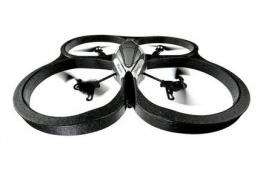Review: iPhone-controlled drone fun but expensive

(AP) -- You can pretty much do anything with your iPhone these days - control your digital video recorder from afar, unlock your car, and now, fly a drone.
Parrot, a company known more for its Bluetooth handsfree car speakerphones, has launched a small, unmanned aircraft that can be controlled using an iPhone or another of Apple Inc.'s Wi-Fi-enabled gadgets, including the iPod Touch and the iPad. After reading about it online, I felt compelled to take the drone for a test drive because, honestly, what gadget geek wouldn't want one?
The $300 AR.Drone is a quadricopter - a helicopter with four separate propellers - made of carbon fiber and strong plastics.
Weighing less than a pound, the gadget can fly up to 11 mph, controlled from up to 150 feet away. The drone has two built-in cameras that stream video of what it sees directly to your iPhone, or another Apple device. You then control aspects of the flight by tilting the iPhone from side to side, using the gyroscope in the device.
Don't worry if you don't have a good cellular or Wi-Fi connection. The drone has its own Wi-Fi system to communicate directly with the iPhone without needing to go through an outside Wi-Fi hotspot.
The setup was quite easy. After downloading the free app from Apple's iTunes store and charging the battery for the AR.Drone, I was ready to fly. With one touch of a button on the screen, the AR.Drone was hovering about three feet off the ground. Landing is just as simple, with one on-screen button that slowly lowers the drone to the ground.
Admittedly, the controls take a while to master. The easiest way is to tilt your iPhone to control the flight. There's also an advanced mode, which lets you control the drone with a virtual joystick. It's possible to guide the drone by looking at the video feeds, but I found it much easier to look at the aircraft itself.
Make sure your first test drive is in an open area like a field or big backyard that gives you room to experiment with the controls without crashing into everything. When the drone arrived at my office, colleagues were excited to see it fly. We regretted our haste when initial flights bashed the drone into filing cabinets.
During our outdoor field tests, the drone ended up in a nearby forest. Thankfully, the cameras on the drone gave me an idea of where it crashed. While the drone was noticeably affected by the wind outside, it has technology that tries to minimize the drifting.
You can fly the drone inside buildings more safely by attaching the included plastic foam bumpers, which protect the drone and anything you may run it into. (And trust me, you will run it into things.) If you get into trouble, there's also an emergency landing button that completely shuts off the motors and drops the unit to the ground.
I was able to master flying it after a couple of sessions, but was always cautious about where I flew it.
As fun as the AR.Drone is to fly, there are a few downsides. The battery only lasts about 15 minutes when fully charged, so if your flight requires a long drive to an open football field or parking lot, it might not feel worth it. You can, however, buy extra batteries for $30 each.
And, for now, the app used with the AR.Drone only controls flying movements and displays feeds from the on-board cameras.
But I find the future possibilities exciting. Parrot plans to update its app with augmented reality games. You can race other actual drones or chase and shoot virtual enemies that appear superimposed on the video feed from the drone.
Parrot also has made its technology for the AR.Drone open source, meaning any programmer can build his or her own games or find other ways to use and control the drone. I could see one that lets users record the video feed or take screen shots while flying.
While it comes with a hefty price tag, the open platform puts the AR.Drone in the category of promising gadgets for those with extra cash to spend. It's fun to play with now, but you might want to wait until you can do more with it.
More information: AR.Drone: http://ardrone.parrot.com
©2010 The Associated Press. All rights reserved. This material may not be published, broadcast, rewritten or redistributed.




















